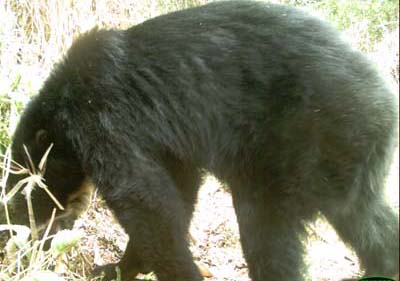Spectacled Bear Conservation Updates
 |
|
The teachers practice activities from the workbook, "Don Oso visits my School". |
|
Don Oso Program recognized for Best Lessons Learned
(16 September 2013) The Eco-Index of Rainforest Alliance has recognized the Don Oso Program a third time for ¨Best Lessons Learned¨ in August 2013. One lesson learned is that community and park planning for natural resource conservation must address the role of legal, privately-owned land within national park boundaries. Top-down mandates will not adequately protect local resources on private lands and should be dismissed.
Don Oso Program trains 15 teachers in and around Sangay National Park
The Don Oso education program collaborated closely with the Ecuadorian Ministry of Education and park officials of Sangay National Park to train 15 teachers in the use and application of the educational workbook, ¨Don Oso visits my School¨. The teachers work in communities directly adjacent to Sangay National Park. While some teachers have previously worked with this program, many teachers are new and with little knowledge about the local environment. The six-hour workshop included a review of the workbook followed by opportunities to practice and present activities to the group. Each participant received an activity book and implementation guide to use in their classroom.
Don Oso, Fundación Cordillera Tropical staff and the Ministry of Education’s regional supervisors will pay a follow-up visit to each participating school in the coming six months. The visit will provide teachers with support and feedback on their efforts to incorporate information about locally endangered species, the spectacled bear, into the curriculum.
Ph.D. student Becky Zug leads study investigating the role of private lands in Andean bear conservation
Becky Zug, Candidate for a Ph.D. at the University of Wisconsin-Madison, is using motion sensor cameras to photograph bears in a 40 square kilometer study area within and adjacent to Sangay National Park. Her two-year project examines how Andean, or spectacled, bears use private property.
 |
|
A photo-captured Andean, or spectacled, bear. |
|
During the study’s first 12-months, her cameras have found the most abundant groups of species to be small and medium sized mammals, including rodents, coati, and deer species. Large and medium-sized carnivores, such as the Andean bear, puma, and Andean fox, have been photographed at about half that rate.
She has also found that not all species use each property, suggesting that some forest types may be better than others for species such as bears and pumas. Currently, about half of the participating properties have no photographs of bears during the 12-month project period. A second year of work on these same properties aims to support or refute these preliminary conclusions.
Funding and support
The Don Oso Conservation Program represents a collaboration between scientists at the University of Wisconsin-Madison (USA), the Ecuadorian Ministry of Environment, communities in the Nudo del Azuay, the Corps of Community Park guards, and the Fundación Cordillera Tropical. The Don Oso Conservation Program currently receives generous funding from the Disney Worldwide Conservation Fund, the Overbrook Foundation, and the University of Wisconsin-Madison.
